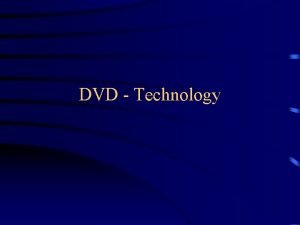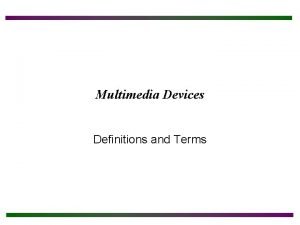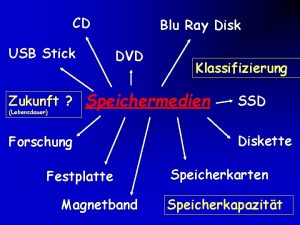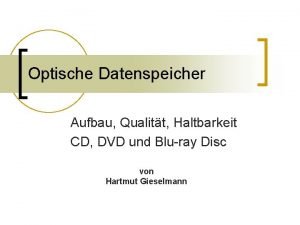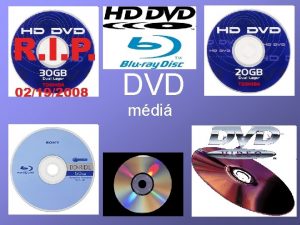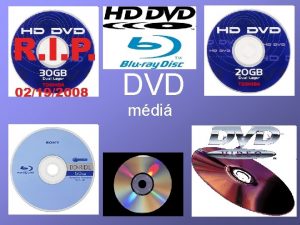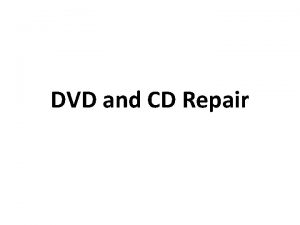DVD Technology The DVD Family G The Technologies













- Slides: 13

DVD - Technology

The DVD Family G The Technologies äDVD-ROM äDVD-RAM äDVD-R äDVD+RW äDVD-Audio äDVD-Video ähttp: //www. pctechguide. com/10 dvd. htm

DVD History G Originally two competing developments äMMCD backed by Sony & Philips äSD backed by Toshiba, Matsushita & Time Warner G 1995 - group of computer companies led by IBM insisted on single standard G 1997 - DVD Forum created G International standards developed by ECMA

DVD Technology G Like CDs, DVDs use a track of pits signifying binary information on a disc, which is read by an optical pickup. DVD has the same dimensions as CD, but a much higher capacity and data transfer rate. G Differences between DVD and CD äTrack pitch: DVD = 0. 74 m v. CD = 1. 6 m äMinimum Pit Length: DVD= 0. 4 m v. CD = 0. 84 m

DVD Technology G DVD can hold anywhere from seven times to over 25 times the digital data on a CD G There are three reasons for DVD's greater data capacity: 1. Smaller pit size 2. Tighter track spacing 3. Multiple layer capability

DVD Technology A comparison of a CD's pit size and track spacing vs. that of a DVD

DVD Technology (cont. ) G Data density of DVD is 4. 5 times CD ä Capacity of one-sided, single layer disc is 4. 7 GB ä Higher capacities can be achieved by using both sides of the disc and up to two layers per side: ÛSingle-sided, single-layer (4. 7 GB) – known as DVD-5 – The "5" in "DVD-5" signifies the nearly 5 GBytes worth of data capacity ÛSingle-sided, double-layer (8. 5 GB) – DVD-9 – the DVD player automatically switches to the second layer in a fraction of a second, by re-focusing the laser pickup on the deeper second layer. This capability allows for uninterrupted playback of long movies up to four hours

DVD Technology ÛDouble-sided, single-layer (9. 4 GB) – Known as DVD-10, this construction features a capacity of 9. 4 GBytes of data. DVD-10 s are commonly used to put a widescreen version of the movie on one side, and a full frame version of the same movie on the other side ÛDouble-sided, double-layer (17. 0 GB) – The DVD-18 construction can hold approximately 17 GBytes (almost 26 times the data capacity of a CD), or about 8 hours of video and audio as a DVD-Video. Think of DVD-18 as a doublesided DVD-9, where up to four hours of uninterrupted video and audio can be stored on one side Û 1 hour of MPEG-2 video = 2. 2 GB

DVD Technology (cont. ) G The technique for double-layering a DVD disc is of particular importance: äouter layer is semi-transparent [18 -30% reflectivity] äinner layer is more reflective [50 -80% reflectivity] äpickup lens is refocused to read desired layer äextra lead-out space required on inner layer ätwo methods of writing the layers ÛParallel track path (PTP) ÛOpposite track path (OTP) - allows near continuous read

Recordable DVD G Most common form is DVD-RAM äuses phase-change recording to provide rewriteable, erasable discs with 2. 6 GB per side capacity äphase-change uses a recording medium that can exist in both a crystalline and an amorphous state ärecording takes place by changing surface of disc to amorphous state, to represent the presence of data, by heating it with a laser

Recordable DVD G DVD-R äcompatible with DVD-ROM äinterchangeable with all other formats ätake-up slow, so drives are very expensive G DVD+RW änot adopted by DVD Forum as official standard äsimilar technique to DVD-RAM, 3 GB per side äactively supported by HP [drive], Philips & Sony

New Stuff G DVD-Audio äno audio standard in 1996 release äDVD-Audio 1. 0 standard approved by DVD Forum and released in March 1999 ärelease of products slowed by compliance with SDMI, uses Verance encryption & watermarking äDVD-Video players have better than CD sound

New Stuff (cont. ) äUniversal players will not be available for some time, so DVD-Audio discs will not necessarily play on existing DVD-Video players äSony & Philips have developed a competing format, Super Audio CD (SACD) Ûprovides a two layer approach, one for existing CD players plus one for high-density DVD-Audio Ûextremely expensive!! äIncompatibility between DVD-Audio, DVD-Video and DVD-ROM remains a problem
 äsd
äsd E commerce architecture and technologies in web technology
E commerce architecture and technologies in web technology Conclusion on topic family
Conclusion on topic family Varies from family to family on the periodic table
Varies from family to family on the periodic table Blended family vs binuclear
Blended family vs binuclear Is dvd drive a multimedia device
Is dvd drive a multimedia device The purpose of digital graphics
The purpose of digital graphics Print replacement dvd covers
Print replacement dvd covers Action film dvd covers
Action film dvd covers Luggage is countable or uncountable
Luggage is countable or uncountable Blu ray lebensdauer
Blu ray lebensdauer Advantages of tape recorder in education
Advantages of tape recorder in education Haltbarkeit blue ray
Haltbarkeit blue ray Turilas ja jäärä dvd
Turilas ja jäärä dvd
